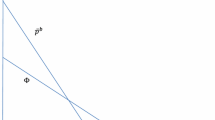Abstract
Most work on taxation assumes that market adjustments to taxation will be small and continuous and so analyzes the effects of taxation using standard marginal methods. However, the world often changes in large and discontinuous ways. This paper looks at the effects of taxation when discontinuities in market adjustments are allowed because market structure is determined endogenously by the discrete entry and exit decisions of firms. The results indicate that the potential for discontinuities generates tax effects that are considerably different from those that emerge when adjustments are small and continuous. With discontinuities, taxes can have large and discrete effects, for example, by increasing prices far in excess of the tax itself or by changing utility in a highly nonmarginal way. Of more significance, with discontinuities taxes can actually increase welfare even when they lessen competition and raise prices. Taxes can also have markedly different effects on the income and welfare of different groups. Consumers are always made worse off by a tax, but a tax may be supported by the firms in an industry if the tax limits entry and thereby increases firm profits.
Similar content being viewed by others
References
Abe, Kenzo. (1988). “Anatomy of Tax Incidence in the Initially Distorted Economy of Variable Returns to Scale”Journal of Public Economics 37, 113–120.
Anderson, Robert, and J. Gregory Ballentine. (1976). “The Incidence and Excess Burden of a Profits Tax Under Imperfect Competition”Public Finance/Finances Publiques 31(2), 159–175.
Arnott, Richard, and Ronald E. Grieson. (1981). “Optimal Fiscal Policy for a State or Local Government”Journal of Urban Economics 9, 23–48.
Atkinson, Anthony B., and Joseph E. Stiglitz. (1980).Lectures on Public Economics. New York: McGraw-Hill.
Auerbach, Alan J. (1985). “The Theory of Excess Burden and Optimal Taxation” In Alan J. Auerbach and Martin Feldstein (eds.),Handbook of Public Economics (Vol. 1) (pp. 61–127). New York: Elsevier Science.
Bartik, Timothy J. (1991).Who Benefits from State and Local Development Policies? Kalamazoo, MI: W.E. Upjohn Institute.
Besley, Timothy. (1989). “Commodity Taxation and Imperfect Competition: A Note on the Effects of Entry”Journal of Public Economics 40, 359–367.
Davidson, Carl, and Lawrence W. Martin. (1985). “General Equilibrium Tax Incidence Under Imperfect Competition: A Quantity-Setting Supergame Analysis”Journal of Political Economy 93(6), 1212–1223.
Davidson, Carl, and Lawrence W. Martin. (1991). “Tax Incidence in a Simple General Equilibrium Model with Collusion and Entry”Journal of Public Economics 45, 161–190.
Helpman, Elhanan. (1981). “International Trade in the Presence of Product Differentiation, Economies of Scale, and Monopolistic Competition: A Chamberlinian-Heckscher-Ohlin Approach”Journal of International Economics 11, 304–340.
Hortsmann, Ignatius J., and James R. Markusen. (1987). “Strategic Investments and the Development of Multinationals”International Economic Review 15, 109–121.
Horstmann, Ignatius J., and James R. Markusen. (1992). “Endogenous Market Structures in International Trade”Journal of International Economics 32, 109–129.
Konishi, Hideki, Masahiro Okuno-Fujiwara, and Kotaro Suzumura. (1990). “Oligopolistic Competition and Economic Welfare: A General Equilibrium Analysis of Entry Regulation and Tax-Subsidy Schemes”Journal of Public Economics 42, 67–88.
Kotlikoff, Laurence, J., and Lawrence H. Summers. (1987). “Tax Incidence” In Alan J. Auerbach and Martin Feldstein (eds.),Handbook of Public Economics (Vol. 2) (pp. 1043–1092). New York: Elsevier Science.
Linneman, Ludger. (1991). “Endogenous Market Structure, Multinational Enterprises, and Technical Progress” University of Heidelberg, Department of Economics Working Paper.
Markusen, James R. (1984). “Multinationals, Multi-Plant Economics, and the Gains from Trade”Journal of International Economics 16, 205–226.
Markusen, James R., Edward R. Morey, and Nancy D. Olewiler. (1993). “Environmental Policy When Market Structure and Plant Locations Are Endogenous”Journal of Environmental Economics and Management 24, 69–86.
McLure, Charles E., Jr. (1969). “Interregional Incidence of General Regional Taxes”Public Finance/Finances Publiques 24, 457–483.
McLure, Charles E., Jr. (1970). “Taxation, Substitution, and Industrial Location”Journal of Political Economy 78(1), 112–132.
Mintz, Jack M., and Jesus Seade. (1990). “Small Enterprise Corporate Tax Policy: Effects on Market Price, Industry Profits and Allocative Efficiency in a Dominant Firm Model” Queen's University, Department of Economics Working Paper.
Mintz, Jack M., and Henry Tulkens. (1986). “Commodity Tax Competition Between Member States of a Federation: Equilibrium and Efficiency”Journal of Public Economics 29, 133–172.
Schmitt, Nicolas. (1991). “Endogenous Market Structures with Trade in Differential Products” Simon Fraser University, Department of Economics Discussion Paper No. 91–04.
Stern, Nicholas (1987a). “The Theory of Optimal Commodity Taxation and Income Taxation: An Introduction” In David Newberry and Nicholas Stern (eds.),The Theory of Taxation for Developing Countries (pp. 22–59). Washington, DC: Oxford University Press for the World Bank.
Stern, Nicholas (1987b). “The Effects of Taxation, Price Control, and Government Contracts in Oligopoly and Monopolistic Competition”Journal of Public Economics 32, 133–158.
Wildasin, David E. (1989). “Interjurisdictional Capital Mobility: Fiscal Externality and a Corrective Subsidy”Journal of Urban Economics 25, 193–212.
Wilson, John D. (1986). “A Theory of Interregional Tax Competition”Journal of Urban Economics 19, 296–315.
Author information
Authors and Affiliations
Rights and permissions
About this article
Cite this article
Alm, J., Thorpe, S.G. Taxation, imperfect competition, and discontinuities. Int Tax Public Finan 2, 419–438 (1995). https://doi.org/10.1007/BF00872775
Issue Date:
DOI: https://doi.org/10.1007/BF00872775




